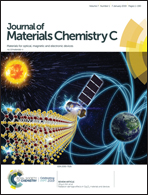Dual nature of exciplexes: exciplex-forming properties of carbazole and fluorene hybrid trimers†
Abstract
Two exciplexes were detected for the first time for the known exciplex-forming system consisting of electron donating 1,3-bis(N-carbazolyl)benzene and electron accepting 2,4,6-tris[3-(diphenylphosphinyl)phenyl]-1,3,5-triazine. Exploiting thermal treatment, sky-blue (high-energy) and orange (low-energy) exciplexes were observed for a solid-state mixture of the compounds under electrical excitation. Similarly, stable high-energy and low-energy exciplexes were observed for new exciplex-forming systems consisting of 2,4,6-tris[3-(diphenylphosphinyl)phenyl]-1,3,5-triazine and one of four selected carbazole and fluorene hybrid trimers as donors. The high-energy exciplexes were observed when there was a small energy barrier between the locally excited state and the high-energy exciplex state. A large energy barrier between the locally excited state and the low-energy exciplex state was the reason that the dual nature of exciplexes was not discovered yet. Emission of both exciplexes was observed in electroluminescence spectra of exciplex-interface based devices using developed exiplex-forming systems as emitters. Observed under optical and electrical excitations, the low-energy exciplexes were separated using thermal treatment of the studied exciplex-forming systems. The exciplex-forming system consisting of 2,4,6-tris[3-(diphenylphosphinyl)phenyl]-1,3,5-triazine and 3,6-di(9-carbazolyl)-9-(2-ethylhexyl)carbazole, which exhibits thermally activated delayed fluorescence, showed the best performance in organic light-emitting diodes (OLEDs) based on interface and volume exciplex emitters. The best device showed maximum external quantum and maximum current efficiencies of 18% and 54 cd A−1 respectively. Additionally, white OLEDs were fabricated exploiting sky-blue and orange emissions from a single exciplex-forming system. Our findings provide evidence of the dual nature of exciplexes and pave the way towards design of new exciplex-forming systems with high photoluminescence quantum yields and efficient exciplex-based devices.



 Please wait while we load your content...
Please wait while we load your content...